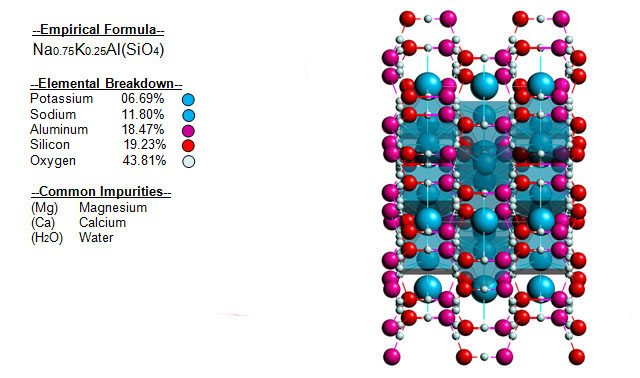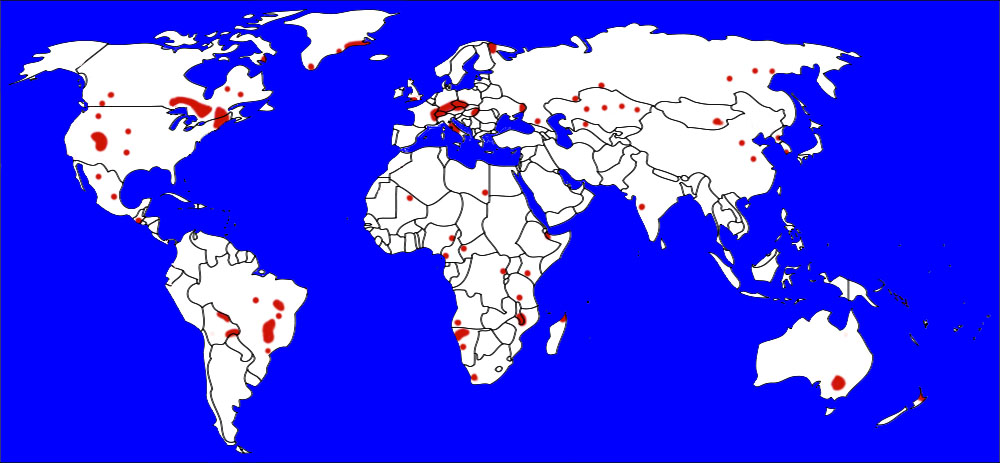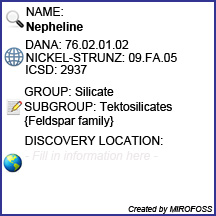

| Mineral Name | Nepheline |
| First Discovered | 1801 |
| Nickel-Strunz Classification | 09.FA.05 |
| Dana Classification | 76.02.01.02 |
| ICSD | 2937 |
| Mineral Group | Silicates |


| Cleavage | Poor |
| Colour(s) | White, Gray, Brown, Brownish gray, Reddish white |
| Specific Gravity | 2.59 |
| Diaphaneity | Transparent to Translucent to Opaque |
| Fracture | Sub Conchoidal - Fractures developed in brittle materials characterized by semi-curving surfaces. |
| Mohs Hardness | 6.0 |
| Luminescence | Non-fluorescent |
| Luster | Vitreous - Greasy |
| Streak | White |
| Habit(s) | Massive to Prismatic |
| Radioactivity | Non-radioactive |
| Magnetism | Non-magnetic |

No known health risks have been associated with nepheline. However ingestion of nepheline, as with other naturally occurring minerals, is not recommended.

The following image shows the elemental breakdown of the mineral nepheline along with the mineral crystal structure.


| Crystal System | Hexagonal |  |
| Class | Pyramidal | |
| Axial Ratios | a : c = 1 : 0.83966 | |
| Morphology | Long to short prismatic | |
| Optical Data Type | Uniaxial (-) | |
| Dichroism (e) | Colourless | |
| Dichroism (w) | Turbid gray | |
| RL Values | nω = 1.529 - 1.546 nε = 1.526 - 1.542 | |
| Max Birefringence | δ = 0.003 - 0.004(See colour chart at right) |  |
| Surface Relief | Low | |
| Dispersion | None | |

Nepheline can be referenced in certain current and historical texts under the following eight names:
The mineral nepheline can be translated into the following select languages:
| Arabic | نفلين | Bulgarian | нефелин | Chinese (Sim) | 霞石 |
| Croatian | Czech | nefelinický | Danish | nephelin | |
| Dutch | nefeliensyeniet | Esperanto | Estonian | ||
| Finnish | nefeliini | French | German | Carolinit | |
| Greek | νεφελίνης | Hebrew | Hungarian | nefelin | |
| Italian | nefelina | Japanese | 霞石 | Korean | 하석 |
| Latin | Lithuanian | Norwegian | nefelin | ||
| Persian | نفلین | Polish | sjenit | Portuguese | nefelina |
| Romanian | nefelin | Russian | Нефелин | Slovak | nefelinický |
| Spanish | Carolinita | Swedish | nefelin | Tagalog | |
| Turkish | nefelin | Ukrainian | нефелін | Vietnamese |

Nepheline can be found in many places around the world. The map below shows major documented concentrations of nepheline:


 |
The MIROFOSS database offers free printable geological identification tags for personal and non-profit use. These tags can be used to properly identify mineral samples in your collection. -Click here- to download a full size jpeg image for a nepheline identification tag; which can be printed on paper or used with a plastic laser printer. |
 |
What's this? What can I do with it? |

| Chemical Composition | Vulić, P., Balić-Žunić, T., Belmonte, L.J., Kahlenberg, V. (2011): Crystal chemistry of nephelines from ijolites and nepheline-rich pegmatites: influence of composition and genesis on the crystal structure investigated by X-ray diffraction. Mineralogy and Petrology, 101, 185-194. |
| Crystallography | Friese, K., Grzechnik, A., Petrícek, V., Schönleber, A., van Smaalen, S., Morgenroth, W. (2011): Modulated structure of nepheline. Acta Crystallographica, B67, 18-29. |
| History | American Mineralogist (1972): 57: 1711-1719. |
| History | Rastsvetaeva, R.K., Aksenov, S.M., Chukanov, N.V. (2010): Disordering of Al and Si in nepheline from Graulai (Germany). Doklady Chemistry, 435, 339-342 |
| Geographical Data | Mindat.org. Retrieved on 2013-03-25 |
| Physical Identification | Webmineral.com. Retrieved on 2013-03-25. |
| March 28, 2013 | The last time this page was updated |
| ©2015 MIROFOSS™ Foundation | |
 |
Powered By Dynamo™ |